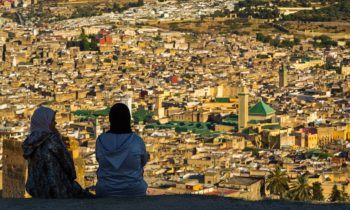Ian Black in The Guardian:
 Outside the window of Tim Mackintosh-Smith’s home in Sana’a, the Yemeni capital, are reminders of the long sweep of Arab history – child soldiers mourning martyrs of the country’s ongoing war, rocket salvoes, sectarian rivalries, hypnotic slogans and a mosque dating back to the seventh century and the rise of Islam in the Arabian peninsula. The view is simultaneously rich, bleak and thought-provoking: for three millennia, dynasties have come and gone, from the Sabaeans and Himyaris to the Umayyads of Damascus and the Abbasids of Baghdad. Later came the al Saud – the family that gave its name to a still powerful kingdom. Interactions between desert (badu) and town (hadar), semi-nomadic tribes and settled peoples, strong men and weak institutions, are a constant theme. Language, faith, and loyalty come together in complex and far-flung combinations.
Outside the window of Tim Mackintosh-Smith’s home in Sana’a, the Yemeni capital, are reminders of the long sweep of Arab history – child soldiers mourning martyrs of the country’s ongoing war, rocket salvoes, sectarian rivalries, hypnotic slogans and a mosque dating back to the seventh century and the rise of Islam in the Arabian peninsula. The view is simultaneously rich, bleak and thought-provoking: for three millennia, dynasties have come and gone, from the Sabaeans and Himyaris to the Umayyads of Damascus and the Abbasids of Baghdad. Later came the al Saud – the family that gave its name to a still powerful kingdom. Interactions between desert (badu) and town (hadar), semi-nomadic tribes and settled peoples, strong men and weak institutions, are a constant theme. Language, faith, and loyalty come together in complex and far-flung combinations.
Arabs retells a familiar story in unexpected ways. It focuses first on the social and economic changes (the domestication of the camel was key) that shaped the pre-Islamic world before the transformation that began in Mecca in AD622. Perfumes and gems were the precursors of the petroleum and gas of modern times. In the background were always challenges from Assyrians, Persians, Romans and Mongols, narrated and fought by a colourful cast of oracles, orators and commanders of dogged, lightly equipped horse-mounted warriors. Mackintosh-Smith is an unusual Englishman abroad: a writer who lives, as he puts it, in a land not a library, experiencing history in situ. He combines deep learning with penetrating insights delivered with dazzling turns of phrase and illuminating comparisons.
More here.
